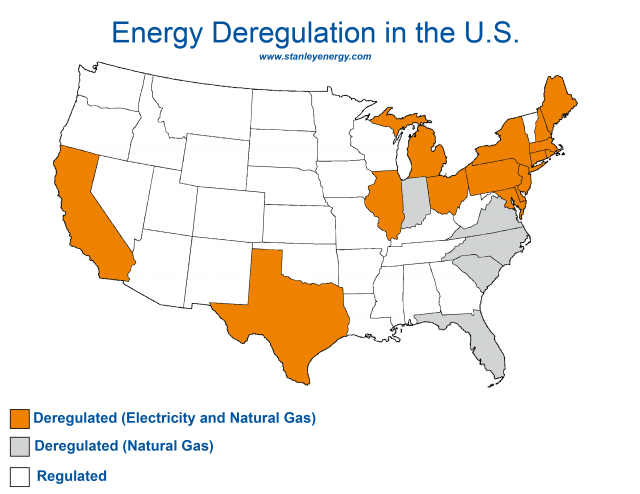First, you need to verify that your state is deregulated for the energy source you wish to purchase in a competitive market. Next you must determine whether you have the capability and expertise in-house to find the right supplier and products for your organization. Purchasing energy supply through a competitive supplier is risky if the purchaser in uninformed or unfamiliar with how energy markets work. Brokers and aggregators negotiate power purchase agreements on a daily basis and have a good real time feel for the market and where it’s heading. Oftentimes a broker and or aggregator can procure energy at much lower rates than an end-user could get on its own. Make sure to follow our energy deregulation checklist before determining the best way to purchase energy.
 Energy Aggregators
Energy Aggregators
Aggregation is the grouping of utility customers to purchase as a group. Pooling purchasing power could result in more favorable pricing compared to the individual members purchasing based solely on their unique usage. Developing the right energy purchasing strategy is a complex challenge for busy facilities managers or business owners wearing many different “hats” within an organization. A reputable and qualified energy aggregator or broker acting as an independent energy advisor can help guide the person responsible for energy costs. Outsourcing procurement often results in significantly higher savings for the end user while mitigating downside risk. Choosing the right partner is crucial to maximizing the advantages created through deregulated energy markets.
Advantages:
- You can reduce internal administrative expenses and maintain focus on your core business. The energy market is complicated and it may make sense for you and your business to outsource procurement services to a company specializes in energy procurement to save you money and time.
- You can share fees with other entities in an aggregation group. This is an advantage for any entity because you can likely spread the aggregation/broker fees out with the other entities in the aggregation group. Lower fees combined with more purchasing power will result in further cost reductions.
- Suppliers are more interested and pay more attention (more competition) with a larger purchasing block. Economies of scale come into play for aggregators. The more KWH combined in an aggregation pool lowers the fixed cost/KWH and results in lower rates for the users involved in the aggregation group.
- -Lower rates result from combining dissimilar user profiles. Some businesses use more energy in the winter months and others in the summer. Irregular usage may result in higher rates from competitive markets because the suppliers can’t forecast usage throughout the year. Joining an aggregation comprised of end-users with dissimilar usage profiles may result in lower rates.
Factors to consider before joining an aggregation:
- Size of load – The amount of energy your building or business consumers during a period of time (Kwh or Btu).
- Load profile – Your profile refers to how or when you use energy. Some businesses use approximately the same amount each month. Other businesses, for instance seasonal businesses, use more energy in some months and significantly less during other months. The inconsistent usage may increase pricing available to a particular customer.
- Risk tolerance – Different products present different levels of risk. You should evaluate the appropriate level of risk for your firm before determining the best product.
- Contract length flexibility – You should verify that the contract length for the aggregation group fits your particular risk profile and needs.





 The high level concept of energy deregulation is defined as when government reduces its role and allows industry greater freedom in how it operates. Similar to deregulation in other industries like telecommunication and transportation, energy deregulation involves the purchase of electricity and natural gas through a competitive market. In a regulated market, commercial, industrial and residential users of electricity and natural gas are forced to buy energy through the utility without competition.
The high level concept of energy deregulation is defined as when government reduces its role and allows industry greater freedom in how it operates. Similar to deregulation in other industries like telecommunication and transportation, energy deregulation involves the purchase of electricity and natural gas through a competitive market. In a regulated market, commercial, industrial and residential users of electricity and natural gas are forced to buy energy through the utility without competition.